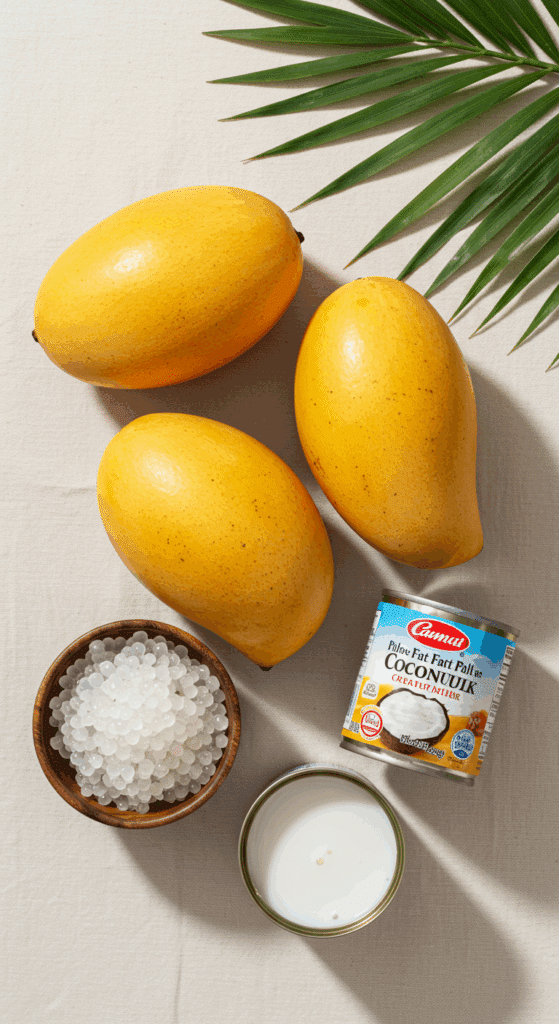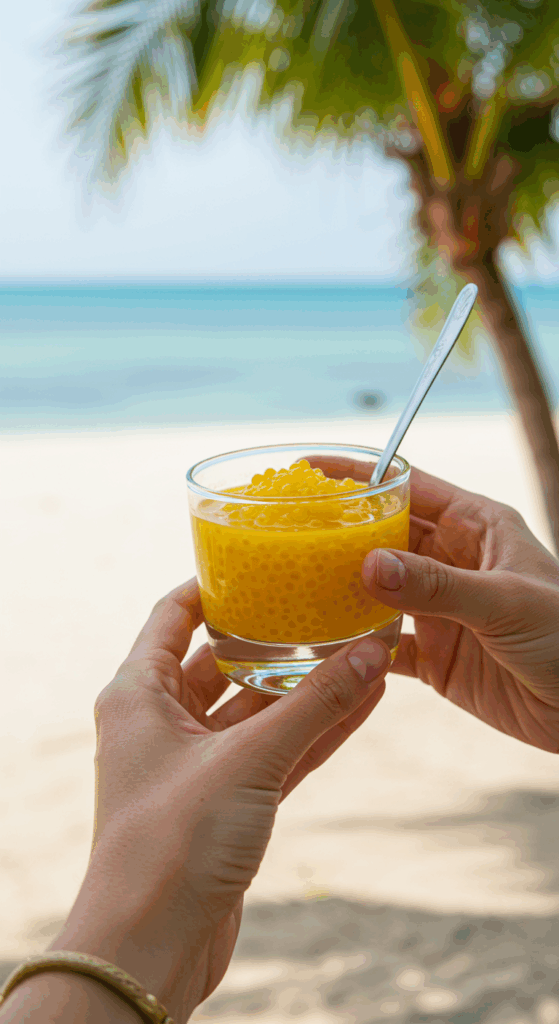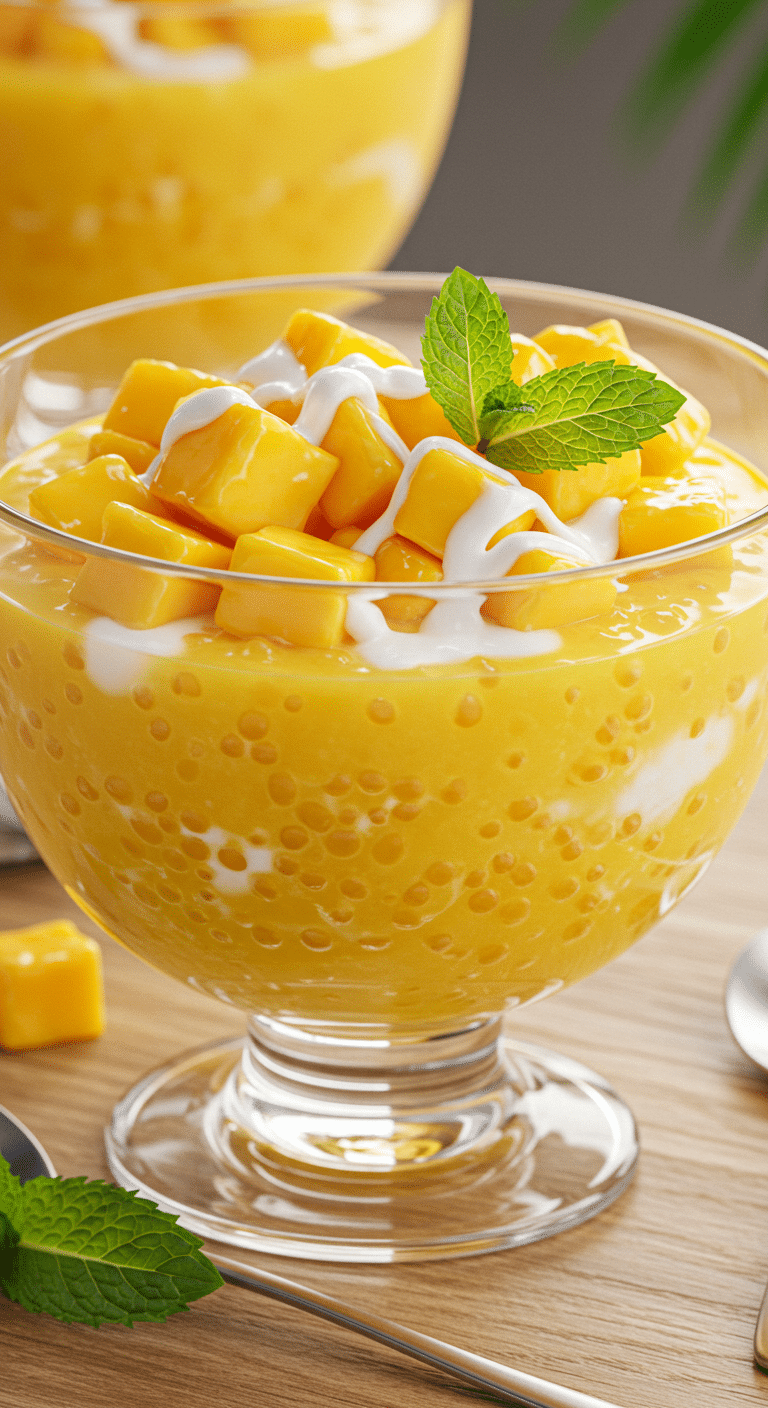Are you dreaming of a dessert that tastes like a tropical vacation in a bowl? A treat that’s cool, creamy, and absolutely bursting with the sweet, luscious flavor of ripe mangoes, with the fun, chewy surprise of sago pearls in every spoonful? This incredible, easy-to-make Mango Sago is the ultimate refreshing dessert from Southeast Asia that is about to become your new obsession.
This isn’t just a recipe; it’s a taste of paradise. Mango Sago is a beloved classic dessert popular across Asia, from Hong Kong to the Philippines, for a reason. It’s a simple, chilled, pudding-like “soup” made from a smooth purée of fresh mango and creamy coconut milk, studded with delightful, chewy tapioca pearls (sago). It’s a naturally gluten-free, surprisingly simple, and utterly delicious way to cool down on a warm day.
Table of Contents
Table of Contents
Recipe Overview: A Taste of the Tropics, Made Easy
What makes this Mango Sago recipe a global sensation is its incredible, refreshing flavor and its unique and satisfying texture. The star of the show is the sweet, floral flavor of ripe mangoes, which are blended into a rich and creamy base with coconut milk. The addition of chewy sago pearls makes every spoonful fun and interesting. It’s a sophisticated yet simple dessert that is perfect for making ahead and serving to guests.
| Metric | Time / Level |
| Total Time | 45 minutes (plus chilling time) |
| Active Prep Time | 20 minutes |
| Difficulty Level | Easy |
| Servings | 6-8 |
The Essential Ingredients for Perfect Mango Sago
This recipe uses a handful of simple, high-impact ingredients to create its signature tropical flavor. The quality of your mangoes and sago will make all the difference!
- Sago (Small Tapioca Pearls): This is what gives the dessert its signature chewy texture.
- What are they?: “Sago” and “small tapioca pearls” are often used interchangeably for this dessert. They are small, starchy spheres made from the pith of the sago palm or, more commonly, from the cassava root (tapioca). When cooked, they become translucent, soft, and delightfully chewy, similar to mini boba pearls.
- Ripe, Sweet Mangoes: The success of this dish depends on using the best mangoes you can find. You want mangoes that are intensely sweet, fragrant, and not fibrous.
- Best Varieties: Look for yellow-skinned mangoes like Ataulfo (also called Honey or Champagne mangoes), which are known for their sweet, honey-like flavor and non-fibrous, creamy flesh. Other great choices are Kent or Keitt mangoes.
- How to Choose: A ripe mango will have a wonderful, fruity fragrance at the stem and will yield to gentle pressure (like a ripe avocado or peach).
- Full-Fat Coconut Milk: For the richest, creamiest, and most authentic flavor, it is crucial to use canned, full-fat coconut milk. The kind in a carton is too thin for this recipe.
- Sweetened Condensed Milk: This adds a rich sweetness and a silky, smooth texture to the mango base. You can adjust the amount to your liking, depending on the sweetness of your mangoes.

Step-by-Step to the Most Delicious Mango Sago
Follow these simple, detailed steps to create this stunning and refreshing Asian dessert.
Step 1: Cook the Sago Pearls to Perfection
First, bring a large pot of water to a rolling boil. Add the 200g of small tapioca pearls (sago) and stir them immediately with a whisk or spoon.
Pro Tip: Stirring the sago as soon as it hits the hot water is a crucial step to prevent the starchy pearls from sticking together and forming a giant clump at the bottom of the pot.
Lower the heat to maintain a steady simmer and cook the sago for 10 minutes, stirring occasionally.
After 10 minutes, remove the pot from the heat, cover it with a lid, and let it sit, undisturbed, for another 10 minutes. During this time, the residual heat will gently finish cooking the pearls, allowing their centers to become completely translucent without the outsides getting mushy.
Pour the cooked sago into a fine-mesh sieve to drain away all the starchy water. Immediately rinse the sago under cold running water. Then, place the sieve with the sago into a large bowl of cold water, keeping the pearls submerged until you are ready to use them. This stops the cooking process and prevents them from sticking together.
Step 2: Create the Creamy Mango Base
While the sago is cooking, you can prepare the mango base. In a blender, combine the 600g of fresh mango chunks, the can of full-fat coconut milk, and the 50g of sweetened condensed milk.
Blend on high speed until the mixture is completely smooth and creamy.
Give the mixture a taste. If your mangoes were very sweet, it might be perfect as is. If you’d like it a little sweeter, you can add more sweetened condensed milk, a tablespoon at a time, and blend again.
Step 3: Combine and Chill
Pour the smooth mango mixture into a large serving bowl or a pitcher.
Thoroughly drain the cooked sago from the cold water. Add the drained sago to the bowl with the mango mixture. Stir everything together to combine, evenly distributing the chewy pearls throughout the creamy mango soup.
Cover the bowl and place it in the refrigerator to chill for at least 1 to 2 hours, or until it is thoroughly cold.
Step 4: Garnish and Serve
When you are ready to serve, give the chilled Mango Sago a good stir.
Ladle the dessert into small, individual serving bowls or clear glasses.
For a beautiful presentation, you can garnish each serving with a drizzle of extra coconut milk and a few pieces of fresh, diced mango.

The Best Easy & Refreshing Mango Sago Recipe
A simple and refreshing Asian-style dessert, this Mango Sago features chewy, translucent sago (small tapioca pearls) suspended in a smooth and creamy puree. The puree is made by blending fresh mango chunks with coconut milk and sweetened condensed milk. The cooked sago is stirred into the mango base, and the dessert is served chilled, often with additional fresh mango and coconut milk for garnish.
- Prep Time: 15 minutes
- Cook Time: 20 minutes
- Total Time: 1 hour 5 minutes (includes chilling)
- Yield: 4-6 servings
- Category: Dessert
- Method: Boiling, Blending
- Cuisine: Asian-Fusion
- Diet: Gluten Free
Ingredients
- 200 g small tapioca pearls (sago)
- 600 g mango chunks (from about 5 small mangoes)
- 400 g (1 can) coconut milk
- 50 g (about 2.5 tbsp) sweetened condensed milk, or more to taste
- Extra coconut milk and fresh mango chunks, for garnish (optional)
Instructions
- Bring a large pot of water to a boil. Add the sago and stir immediately to prevent clumping.
- Lower the heat to a simmer and cook the sago for 10 minutes.
- Remove the pot from the heat, cover it, and let it sit for another 10 minutes, or until the sago pearls are completely translucent.
- Pour the cooked sago into a fine-mesh sieve to drain. Submerge the sieve in a pot of cold water to keep the pearls from sticking together until ready to use.
- Make the Mango Base: In a blender, combine the mango chunks, coconut milk, and condensed milk. Blend until completely smooth.
- Taste the mixture and add more condensed milk if you prefer it sweeter.
- Assemble: Pour the mango puree into a large serving bowl. Drain the sago well and add it to the mango mixture. Stir to combine.
- Serve the mango sago immediately in small bowls or glasses, or chill for at least 30 minutes.
- Garnish with more coconut milk and fresh mango chunks if desired.
Notes
- The two-stage cooking process for the sago (boiling then resting) is key to ensuring the pearls become fully translucent and cooked through.
- Keeping the cooked sago in cold water is an important step to prevent them from clumping together into a large mass.
- This dessert is best served well-chilled.
Storage and Make-Ahead Tips
Mango Sago is a fantastic make-ahead dessert, perfect for parties.
- Make-Ahead: You can make this dessert completely up to 24 hours in advance and store it in an airtight container in the refrigerator. The flavors will meld beautifully as it chills.
- Storage: Store any leftovers in an airtight container in the refrigerator for up to 3 days. Note that the sago pearls will continue to absorb some of the liquid as they sit, so the dessert may become slightly thicker over time. Simply give it a good stir before serving.
- Freezing: It is not recommended to freeze this dessert, as the texture of the sago pearls can become hard and unpleasant upon thawing.
For more recipe follow my Pinterest account
Creative Recipe Variations
This simple and delicious dessert is a wonderful base for the most famous Mango Sago variation and other fun twists.
- Classic Hong Kong Mango Pomelo Sago: This is the most famous version of this dessert! To make it, prepare the recipe as directed. Then, at the very end, just before serving, gently fold in the pulp (the small, juicy sacs) from one fresh pomelo. If you can’t find a pomelo, a large grapefruit is a great substitute. The slightly bitter, bursting citrus sacs provide an incredible textural and flavor contrast to the sweet mango.
- Add a Tropical Fruit Twist: This dessert is wonderful with other tropical fruits. You can blend in the pulp from 2-3 passion fruits along with the mango for an extra tangy flavor. Or, you can top the finished dessert with fresh diced pineapple, lychees, or kiwi.
- Make it Vegan & Dairy-Free: This dessert is very easy to make vegan. Simply swap the regular sweetened condensed milk for a can of sweetened condensed coconut milk or sweetened condensed oat milk. The flavor will be just as delicious.
Enjoy Your Tropical Getaway in a Bowl!
You’ve just created one of the most refreshing, delicious, and beautiful desserts in the world. This Easy Mango Sago is a true celebration of tropical flavors, with a fun and satisfying texture that is simply irresistible. It’s the perfect, elegant, and surprisingly simple treat to cool you down on a warm day or to end any meal with a taste of paradise.
We hope you love every last, creamy, and chewy spoonful!
If you enjoyed making this recipe, please leave a comment below or share it with a friend who loves mango!
Frequently Asked Questions (FAQs)
Q1: What is the difference between sago and tapioca pearls?
While they are often used interchangeably in recipes like this, they are technically from different plants. True sago is extracted from the pith of the sago palm tree. Tapioca pearls are made from the starch of the cassava root. For this dessert, the small, white pearls labeled as either “sago” or “tapioca pearls” will work perfectly.
Q2: How do I keep my sago or tapioca pearls from clumping together?
The two most important steps are to stir them immediately as you add them to the boiling water, and to rinse them in cold water immediately after they are done cooking. The initial stir prevents them from forming a clump at the bottom of the pot, and the final rinse washes away excess surface starch and stops the cooking process, preventing them from becoming a sticky mass.
Q4: Can I use frozen mango for this recipe?
Yes, you can absolutely use frozen mango chunks, which makes this a great dessert to enjoy year-round! Simply thaw the mango chunks completely before you blend them. You may need to add a little extra sweetened condensed milk, as frozen mango can sometimes be less sweet than fresh, in-season mangoes.
Q5: My Mango Sago seems very thin after I mix it. Is that right?
Yes, when you first mix the Mango Sago, it will have a consistency similar to a thick, smoothie-like soup. It is meant to be a creamy, liquid dessert that you eat with a spoon. It will thicken up slightly as it chills in the refrigerator for a few hours.

